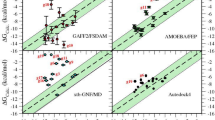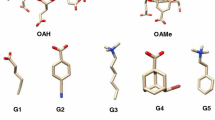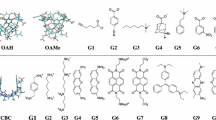Abstract
In this paper, we compute, by means of a non equilibrium alchemical technique, called fast switching double annihilation methods (FSDAM), the absolute standard dissociation free energies of the the octa acids host–guest systems in the SAMPL6 challenge initiative. FSDAM is based on the production of canonical configurations of the bound and unbound states via enhanced sampling and on the subsequent generation of hundreds of fast non-equilibrium ligand annihilation trajectories. The annihilation free energies of the ligand when bound to the receptor and in bulk solvent are obtained from the collection of work values using an estimate based on the Crooks theorem for driven non equilibrium processes. The FSDAM blind prediction, relying on the normality assumption for the annihilation work distributions, ranked fairly well among the submitted blind predictions that were not adjusted with a linear corrections obtained from retrospective data on similar host guest systems. Improved results for FSDAM can be obtained by post-processing the work data assuming mixtures of normal components.









Similar content being viewed by others
References
Rizzi A, Murkli S, McNeill JN, Yao W, Sullivan M, Gilson MK, Chiu MW, Isaacs L, Gibb BC, Mobley DL, Chodera JD (2018) Overview of the SAMPL6 host-guest binding affinity prediction challenge. https://doi.org/10.1101/371724
Yin J, Henriksen NM, Slochower DR, Shirts MR, Chiu MW, Mobley DL, Gilson MK (2016) Overview of the sampl5 host–guest challenge: are we doingbetter? J Comput Aided Mol Des 31(1):1–9
Muddana HS, Fenley AT, Mobley DL, Gilson MK (2014) The sampl4 host-guest blind prediction challenge: an overview. J Comput Aided Mol Des 28(4):305–317
Gibb CL, Gibb BC (2014) Binding of cyclic carboxylates to octa-acid deep-cavity cavitand. J Comput Aided Mol Des 28(4):319–325
Gan H, Gibb BC (2013) Guest-mediated switching of the assembly state of a water-soluble deep-cavity cavitand. Chem Commun 49:1395–1397
Jordan JH, Gibb BC (2015) Molecular containers assembled through the hydrophobic effect. Chem Soc Rev 44:547–585
Torrie GM, Valleau JP (1977) Nonphysical sampling distributions in monte carlo free-energy estimation: umbrella sampling. J Comput Phys 23:187–199
Zwanzig RW (1954) High-temperature equation of state by a perturbation method. i. nonpolar gases. J Chem Phys 22:1420–1426
Kirkwood JG (1935) Statistical mechanics of fluid mixtures. J Chem Phys 3:300–313
Procacci P, Cardelli C (2014) Fast switching alchemical transformations in molecular dynamics simulations. J Chem Theory Comput 10:2813–2823
Sandberg RB, Banchelli M, Guardiani C, Menichetti S, Caminati G, Procacci P (2015) Efficient nonequilibrium method for binding free energy calculations in molecular dynamics simulations. J Chem Theory Comput 11(2):423–435
Procacci P (2016) I. Dissociation free energies of drug-receptor systems via non-equilibrium alchemical simulations: a theoretical framework. Phys Chem Chem Phys 18:14991–15004
Nerattini F, Chelli R, Procacci P (2016) II. Dissociation free energies in drug-receptor systems via nonequilibrium alchemical simulations: application to the fk506-related immunophilin ligands. Phys Chem Chem Phys 18:15005–15018
Crooks GE (1998) Nonequilibrium measurements of free energy differences for microscopically reversible markovian systems. J Stat Phys 90:1481–1487
Procacci P (2015) Unbiased free energy estimates in fast nonequilibrium transformations using gaussian mixtures. J Chem Phys 142(15):154117
Procacci P (2017) Primadorac: a free web interface for the assignment of partial charges, chemical topology, and bonded parameters in organic or drug molecules. J Chem Inf Model 57(6):1240–1245
Procacci P (2016) Hybrid MPI/OpenMP implementation of the ORAC molecular dynamics program for generalized ensemble and fast switching alchemical simulations. J Chem Inf Model 56(6):1117–1121
Cresco: Centro computazionale di ricerca sui sistemi complessi. Italian National Agency for New Technologies, Energy (ENEA). https://www.cresco.enea.it. Accessed 24 June 2015
Consorzio Interuniversitario del Nord est Italiano Per il Calcolo Automatico (Interuniversity Consortium High Performance Systems). http://www.cineca.it. Accessed 22 Jan 2018
GAFF and GAFF2 are public domain force fields and are part of the AmberTools16 distribution, available for download at http://amber.org internet address. Accessed March 2017. According to the AMBER development team, the improved version of GAFF, GAFF2, is an ongoing poject aimed at ”reproducing both the high quality interaction energies and key liquid properties such as density, heat of vaporization and hydration free energy”. GAFF2 is expected ”to be an even more successful general purpose force field and that GAFF2-based scoring functions will significantly improve the successful rate of virtual screenings.”
Giovannelli E, Procacci P, Cardini G, Pagliai M, Volkov V, Chelli R (2017) Binding free energies of host-guest systems by nonequilibrium alchemical simulations with constrained dynamics: theoretical framework. J Chem Theory Comput 12:5874–5886
Giovannelli E, Cioni M, Procacci P, Cardini G, Pagliai M, Volkov V, Chelli R (2017) Binding free energies of host-guest systems by nonequilibrium alchemical simulations with constrained dynamics: illustrative calculations and numerical validation. J Chem Theory Comput 13:5887–5899
Wang L, Wu Y, Deng Y, Kim B, Pierce L, Krilov G, Lupyan D, Robinson S, Dahlgren MK, Greenwood J, Romero DL, Masse C, Knight JL, Steinbrecher T, Beuming T, Damm W, Harder E, Sherman W, Brewer M, Wester R, Murcko M, Frye L, Farid R, Lin T, Mobley DL, Jorgensen WL, Berne BJ, Friesner RA, Abel R (2015) Accurate and reliable prediction of relative ligand binding potency in prospective drug discovery by way of a modern free-energy calculation protocol and force field. J Am Chem Soc 137(7):2695–2703
Marsili S, Signorini GF, Chelli R, Marchi M, Procacci P (2010) Orac: a molecular dynamics simulation program to explore free energy surfaces in biomolecular systems at the atomistic level. J Comput Chem 31:1106–1116
Gilson MK, Given JA, Bush BL, McCammon JA (1997) The statistical-thermodynamic basis for computation of binding affinities: a critical review. Biophys J 72:1047–1069
Zhou H-X, Gilson MK (2009) Theory of free energy and entropy in noncovalent binding. Chem Rev 109:4092–4107
Procacci P, Chelli R (2017) Statistical mechanics of ligand-receptor noncovalent association, revisited: binding site and standard state volumes in modern alchemical theories. J Chem Theory Comput 13(5):1924–1933
Hermans J, Wang L (1997) Inclusion of loss of translational and rotational freedom in theoretical estimates of free energies of binding. Application to a complex of benzene and mutant t4 lysozyme. J Am Chem Soc 119(11):2707–2714
Boresch S, Tettinger F, Leitgeb M, Karplus M (2003) Absolute binding free energies: a quantitative approach for their calculation. J Phys Chem B 107(35):9535–9551
Deng Y, Roux B (2009) Computations of standard binding free energies with molecular dynamics simulations. J Phys Chem B 113:2234–2246
Luo H, Sharp K (2002) On the calculation of absolute macromolecular binding free energies. Proc Natl Acad Sci USA 99(16):10399–10404
Procacci P, Marsili S, Barducci A, Signorini GF, Chelli R (2006) Crooks equation for steered molecular dynamics using a nosé-hoover thermostat. J Chem Phys 125:164101
Park S, Schulten K (2004) Calculating potentials of mean force from steered molecular dynamics simulations. J Chem Phys 120(13):5946–5961
Krishnamoorthy K (2006) Handbook of statistical distributions with applications. Chapman and Hall/CRC, London
Sanders CR (2018) Biomolecular ligand-receptor binding studies: theory, practice, and analysis. Vanderbilt University, Nashville, 2010. https://structbio.vanderbilt.edu/sanders/Binding_Principles_2010.pdf Accessed 22 April 2018
Lauffenburger DA, Linderman JJ (1993) Receptors: models for binding, trafficking, and signaling. Oxford University Press, Oxford
Essmann U, Perera L, Berkowitz ML, Darden T, Lee H, Pedersen LG (1995) A smooth particle mesh ewald method. J Chem Phys 103:8577–8593
Darden T, Pearlman D, Pedersen LG (1998) Ionic charging free energies: spherical versus periodic boundary conditions. J Chem Phys 109(24):10921–10935
Jakalian A, Jack DB, Bayly CI (2002) Fast, efficient generation of high-quality atomic charges. AM1-BCC model: II. Parameterization and validation. J Comput Chem 23(16):1623–1641
Dewar MJ, Zoebisch EG, Healy EF, Stewart JJP (1985) Development and use of quantum mechanical molecular models. 76. Am1: A new general purpose quantum mechanical model. J Am Chem Soc 107(13):3902–3909
Jorgensen WL, Chandrasekhar J, Madura JD, Impey RW, Klein ML (1983) Comparison of simple potential functions for simulating liquid water. J Chem Phys 79:926–935
Parrinello M, Rahman A (1980) Crystal structure and pair potentials: a molecular-dynamics study. Phys Rev Lett 45:1196–1199
Marchi M, Procacci P (1998) Coordinates scaling and multiple time step algorithms for simulation of solvated proteins in the npt ensemble. J Chem Phys 109:5194–520g2
Tuckerman M, Berne BJ (1992) Reversible multiple time scale molecular dynamics. J Chem Phys 97:1990–2001
Procacci P, Paci E, Darden T, Marchi M (1997) Orac: a molecular dynamics program to simulate complex molecular systems with realistic electrostatic interactions. J Comput Chem 18:1848–1862
Levy RM, Gallicchio E (2004) Agbnp: an analytic implicit solvent model suitable for molecular dynamics simulations and high-resolution modeling. J Comput Chem 25:479–499
Sugita Y, Okamoto Y (1999) Replica-exchange molecular dynamics method for protein folding. Chem Phys Lett 314:141–151
Ponti G, Palombi F, Abate D, Ambrosino F, Aprea G, Bastianelli T, Beone F, Bertini R, Bracco G, Caporicci M, Calosso B, Chinnici M, Colavincenzo A, Cucurullo A, Dangelo P, De Rosa M, De Michele P, Funel A, Furini G, Giammattei D, Giusepponi S, Guadagni R, Guarnieri G, Italiano A, Magagnino S, Mariano A, Mencuccini G, Mercuri C, Migliori S, Ornelli P, Pecoraro S, Perozziello A, Pierattini S, Podda S, Poggi F, Quintiliani A, Rocchi A, Scio C, Simoni F, Vita A (2014) The role of medium size facilities in the hpc ecosystem: the case ofthe new cresco4 cluster integrated in the eneagrid infrastructure. In: Proceeding of the International Conference on high performance computing & simulation, Institute of Electrical and Electronics Engineers ( IEEE ) pp 1030–1033
Procacci P, Bizzarri M, Marsili S (2014) Energy-driven undocking (edu-hrem) in solute tempering replica exchange simulations. J Chem Theory Comput 10:439–450
Note that the PMF route to \(K_d\) still needs the definition of a binding site volume, that is of an ”indicator function” [64,31,25] depending on the relative guest-host coordinates that can distinguish between ”bound” state and ”unbound” state
Beutler TC, Mark AE, van Schaik RC, Gerber PR, van Gunsteren WF (1994) Avoiding singularities and numerical instabilities in free energy calculations based on molecular simulations. Chem Phys Lett 222:5229–539
Shenfeld DK, Huafeng X, Eastwood MP, Dror RO, Shaw DE (2009) Minimizing thermodynamic length to select intermediate states for free-energy calculations and replica-exchange simulations. Phys Rev E 80:046705
Naden LN, Shirts MR (2015) Linear basis function approach to efficient alchemical free energy calculations. 2. Inserting and deleting particles with coulombic interactions. J Chem Theory Comput 11:2536–2549
Anderson TW, Darling DA (1954) A test of goodness of fit. J Am Stat Assoc 49:765–769
Stephens MA (1979) Test of fit for the logistic distribution based on the empirical distribution function. Biometrika 66:591–595
Razali NM, Wah YB (2011) Power comparisons of shapiro-wilk, kolmogorov-smirnov, lilliefors and anderson-darling tests. J Stat Model Anal 2:21–33
Islam TU, Tanweer Ul Islam (2017) Stringency-based ranking of normality tests. Commun Stat Simul Comput 46(1):655–668
Dempster AP, Laird NM, Rubin DB (1977) Maximum likelihood from incomplete data via the em algorithm. J Royal Stat Soc B 39:1–38
Gupta MR, Chen Y (2011) Theory and use of the EM algorithm. Found Trends Signal Process 4(3):223–296
An EM Fortran90 code is available with the ORAC6 distribution tarball at the ORAC site. www.chim.unifi.it/orac
MacKerell AD, Bashford D, Bellott M, Dunbrack RL, Evanseck JD, Field MJ, Fischer S, Gao J, Guo H, Ha S, Joseph-McCarthy D, Kuchnir L, Kuczera K, Lau FTK, Mattos C, Michnick S, Ngo T, Nguyen DT, Prodhom B, Reiher WE, Roux B, Schlenkrich M, Smith JC, Stote R, Straub J, Watanabe M, Wirkiewicz-Kuczera J, Yin D, Karplus M (1998) All-atom empirical potential for molecular modeling and dynamics studies of proteins. J Phys Chem B 102(18):3586–3616
Bennett CH (1976) Efficient estimation of free energy differences from monte carlo data. J Comput Phys 22:245–268
Giovannelli E, Gellini C, Pietraperzia G, Cardini G, Chelli R (2014) Combining path-breaking with bidirectional nonequilibrium simulations to improve efficiency in free energy calculations. J Chem Phys 140(6):064104
Chandler D (1987) Introduction to modern statistical mechanics. Oxford University Press, Oxford
Acknowledgements
We acknowledge the Partnership for Advance Computing in Europe (PRACE ) for awarding us access to Marconi-Broadwell and Marconi-KNL HPC platforms managed by the CINECA consortium (Italy). A part of the computing resources and the related technical support used for this work have been provided by CRESCO/ ENEAGRID HPC infrastructure and its staff; see http://www.cresco.enea.it for information.
Author information
Authors and Affiliations
Corresponding author
Rights and permissions
About this article
Cite this article
Procacci, P., Guarrasi, M. & Guarnieri, G. SAMPL6 host–guest blind predictions using a non equilibrium alchemical approach. J Comput Aided Mol Des 32, 965–982 (2018). https://doi.org/10.1007/s10822-018-0151-9
Received:
Accepted:
Published:
Issue Date:
DOI: https://doi.org/10.1007/s10822-018-0151-9




